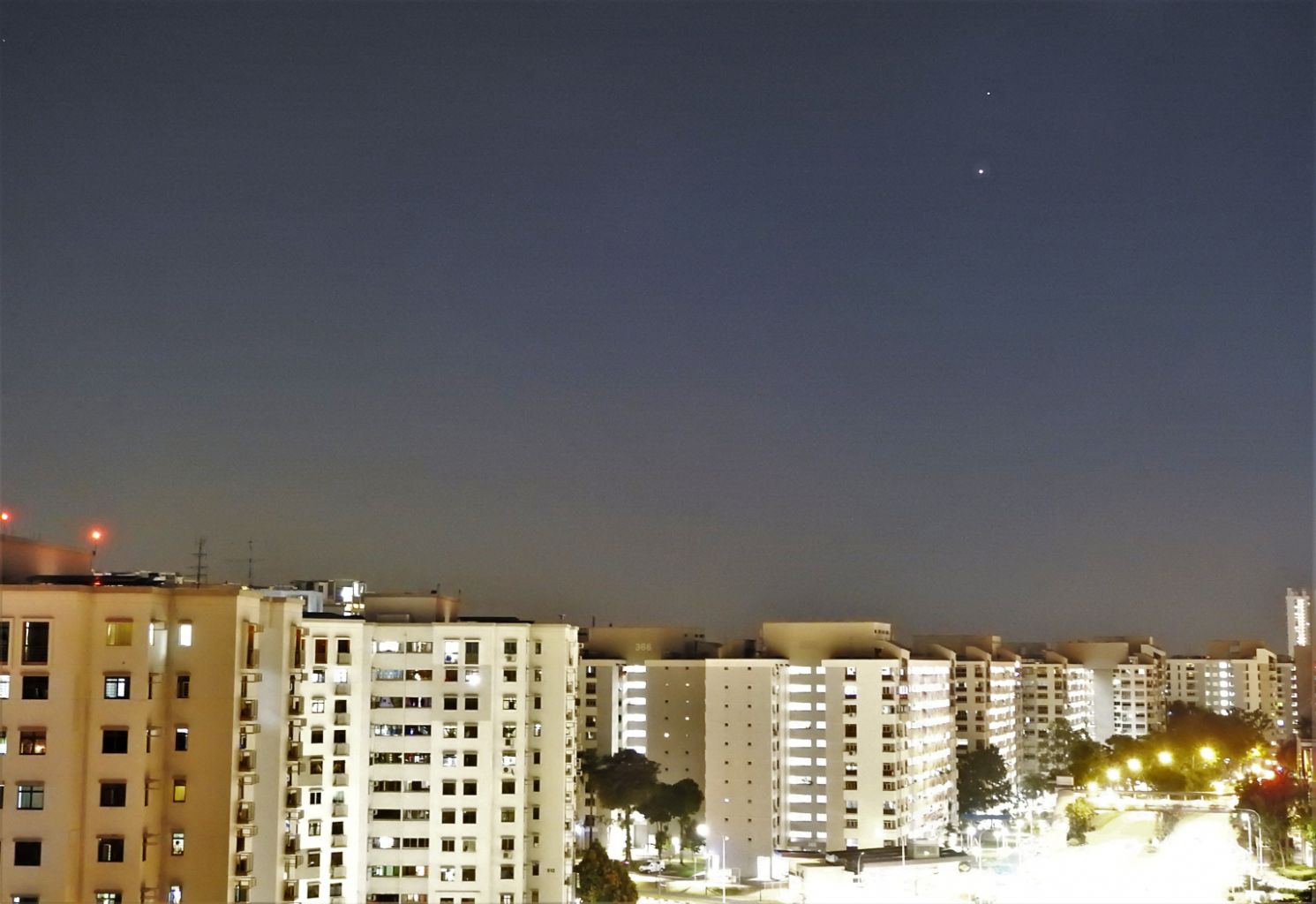Jupiter and Saturn's 'great conjunction': How to observe rare phenomenon on Dec 21
Sign up now: Get ST's newsletters delivered to your inbox

A picture of Saturn (faint dot at the top) and Jupiter (brighter dot at the bottom) in the night sky captured from Woodlands in early December.
PHOTO: A. KANNAN
Follow topic:
SINGAPORE - On Dec 21, the night of the winter solstice, the two largest planets in the solar system will appear to merge in the night sky.
For the past few months, the two gas giants have been "wooing" each other, inching closer and closer in the western part of the night sky.
Currently, the ringed planet is located above and slightly to the right of Jupiter, about 1 degree away.
On a clear night, the planets are seen as white dots in the sky, with Jupiter being closer to Earth and therefore appearing brighter.
As both planets continue tracing their orbits over the next week, they will align closer to each other.
Jupiter has been inching towards Saturn while Saturn has been moving eastwards with respect to background stars.
Next Monday, the giants will be locked in an embrace and create a "double planet" effect, appearing as a brilliant white orb in the sky.
Astronomers have dubbed this romantic spectacle "The Great Conjunction".
The planets have not come this close in centuries. They will be only 0.1 degree apart - which is about the thickness of a dime (a US 10-cent coin) held at arm's length, according to the National Aeronautics and Space Administration (Nasa).
A Centre for Astrophysics, Harvard & Smithsonian spokesman told The New York Times that the alignment will resemble a tipped-over snowman in the sky.
Unlike with eclipses, everyone on Earth will be able to witness this planetary marvel.
Why is The Great Conjunction so rare?
A conjunction in the cosmos happens when two or more celestial bodies cross paths.
Jupiter orbits the sun every 12 years while Saturn takes 29 years. This means that they play catch-up with each other every 20 years.
Although a conjunction between them happens every 20 years, this year's conjunction is special because of how close to each other they will appear.
Dr Abel Yang from the National University of Singapore's physics department says: "Their orbits are slightly tilted with respect to each other so there is a slight difference in their paths. When they usually align, they are not so close to each other because of this difference.
"What makes this year's event rare is that the conjunction happens very close to when their paths appear to cross."
The last time the planets aligned this close was in 1623 but the conjunction was not visible due to the sun's glare. This means that the last people to witness the phenomenon were our ancestors in 1226, almost 800 years ago.
The next Jupiter-Saturn conjunction of this scale will be in 2080.
"Rare celestial events such as these remind us about just how beautiful cosmology and mathematics can be as we deepen our understanding of how the planets orbit and align," said a spokesman for the Science Centre Observatory team.
How can we see it?
The Christmas Star - another name for the rare phenomenon - can be seen with the naked eye but binoculars and telescopes can enhance the viewing experience.
The conjunction can be seen during the entire time that the planets are visible on Dec 21 as well as a few days before and after - but they will not be as close to each other then.
The planets will be visible from 30 minutes after sunset until around 8.45pm in the western and south-western part of the sky.
Dr Yang added that the best time to observe the conjunction will be around 8pm.
A pair of binoculars may show a clearer gap between the two planets. With a telescope, stargazers will be able to see the two planets, their largest moons, and even Saturn's rings.
Astronomy clubs in some tertiary institutions will be holding socially distanced, small-group star-gazing sessions for their members next Monday.
At ITE College East, 15 students from the college's astronomy club will use professional telescopes to witness the conjunction.
If weather permits, the Science Centre Observatory, which is closed to the public, will attempt to live-stream the conjunction on its Facebook page.
The observatory team's spokesman said: "It somehow seems fitting that this very rare celestial event comes as a special gift this holiday season as the rather unprecedented 2020 comes to an end."
A chance to witness a cosmic phenomenon
When
Monday (Dec 21)
Where
• Jupiter and Saturn will be visible in the western-south-western sky.
• The direction of the sunset points to that very part of the sky.
• Stargazers can download sky maps or stargazing apps to pinpoint the location of the planets.
Window of opportunity
• 30 minutes after sunset till about 8.45pm.
• Both planets will set after 9pm.
Ideal vantage points
Places with an unobstructed view of the sky or horizon - for example, carpark rooftops, HDB rooftops, higher floors of HDB flats and buildings, open fields or the seaside.
Identifying the planets
Jupiter and Saturn appear as steady points of light that do not twinkle, with Jupiter being the bigger and brighter of the two.


